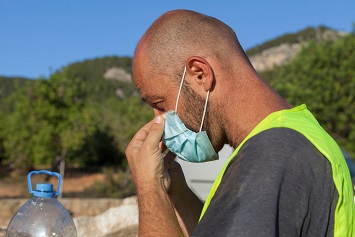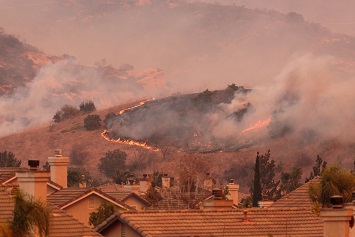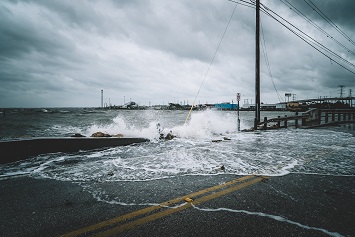Employers now must address a host of summer workplace hazards while continuing to protect workers in an ongoing pandemic. Coronavirus disease 2019 (COVID-19), a respiratory illness caused by the SARS-CoV-2 virus, is widespread in most U.S. communities and considered a workplace hazard.
Worker health and safety risks from heat illness or heat stress can pop up anywhere. While wildfires now are a year-round risk, summer is the height of wildfire season in the Western United States. Teen workers joining the workforce in summer jobs typically lack safety knowledge and training. The Atlantic hurricane season begins to peak in August, and tornado season may soon diminish in the Central United States.
Summer often sees an uptick in construction and other outdoor work that cannot practically be performed in winter. The breadth of summer hazards includes:
- Electrical hazards—electric shock, electrocution, electrical fires, and explosions;
- Falling off of roofs or elevated work platforms or into holes in floors and walls;
- Grain engulfment in bins and silos, as well as other risks in agricultural operations, such as animal-acquired infections, exposures to pesticides and other chemicals, and musculoskeletal injuries from repetitive-motion tasks in both crop and animal production activities;
- Struck-by hazards posed from self-propelled construction equipment and motor vehicles;
- Excavation and trenching hazards like cave-ins or trench collapse; and
- Workplace violence committed by clients or customers, coworkers, or other individuals.
Heat Stress, Illness Prevention
Employers in agriculture, landscaping, construction, and other outdoor industries need to monitor media for National Weather Service heat advisories. Employers of workers who spend a significant amount of time working outdoors, such as security guards and groundskeepers, also should take steps to prevent heat illness. Employers whose workers use un-air-conditioned vehicles for transportation and delivery services also need a heat illness prevention program.
Several states now have heat stress or heat illness prevention standards, but the federal Occupational Safety and Health Administration (OSHA) does not. However, OSHA has cited and fined employers under the General Duty Clause of the Occupational Safety and Health Act of 1970.
Preventing the spread of COVID-19 may complicate efforts to protect workers from heat illnesses. Employers will need to allow enough space and time for employees to take breaks as needed in adequate shade while also maintaining a safe distance from one another. This may entail staggering breaks, increasing shaded break areas, or both.
California’s heat illness prevention standard requires that employers provide shade when workers request it or when temperatures exceed 80 degrees Fahrenheit. Employers and their worksite supervisors also should encourage workers to take a cool-down rest in the shade for at least 5 minutes when they feel the need to do so.
Extra infection prevention measures may be needed at outdoor worksites, such as disinfecting commonly touched surfaces, including water and restroom facilities. To prevent the spread of COVID-19, employers may provide cloth face coverings or allow workers to use their own, as cloth face coverings may help prevent the spread of the disease.
However, employers also must be aware that wearing face coverings can make it more difficult to breathe and harder for a worker to cool off. Additional breaks may be needed to prevent overheating.
In extreme high heat conditions, employers may consider allowing workers to remove face coverings to help prevent overheating if proper physical distancing—at least 6 feet—can be maintained.
In addition to shade and breaks, employers also should provide drinking water for outdoor workers. California’s heat illness prevention standard requires employers to provide fresh, pure, and suitably cool drinking water that is free of charge so each worker at an outdoor worksite can drink at least 1 quart per hour.
Wildfire Smoke Exposures
Exposure to wildfire smoke is an increasingly common workplace hazard, especially in the Western United States. OSHA recommends employers have an evacuation plan in place before a wildfire occurs. An adequate evacuation plan would include what conditions would activate the evacuation plan; a list of emergency functions and who will perform them; specific procedures, exits, and evacuation routes, along with procedures for accounting for personnel, customers, and visitors; the chain of command during an evacuation; and equipment needed.
Last year, California’s Occupational Safety and Health Standards Board approved an emergency “Protection from Wildfire Smoke” standard that went into effect in early August. The emergency standard is effective for 1 year, and state law allows for two emergency readoptions.
California employers must train workers on the emergency standard, the health effects of wildfire smoke, and the safe use and proper maintenance of respirators.
Employers must take steps to protect workers from wildfire smoke when the Air Quality Index (AQI) for airborne particulate matter 2 1/2 microns or less in width (PM 2.5) is 151 or greater. This may entail relocating workers to an enclosed building with adequate ventilation or another outdoor area where the AQI for PM 2.5 is 150 or lower.
If an employer cannot reduce workers’ wildfire smoke harmful exposure to an AQI for PM 2.5 that is 150 or lower, the employer must provide N95 respirators for voluntary use. Respiratory protection is mandatory when the AQI for PM 2.5 exceeds 500.
Federal and state respiratory requirements for medical evaluation and fit testing also apply for respirator use in wildfire smoke protection.
The approaching height of wildfire season coincides with an ongoing shortage of full facepiece respirators (FFRs), such as N95 respirators.
OSHA, the Centers for Disease Control and Prevention (CDC), and the Food and Drug Administration have authorized emergency medical services and healthcare employers to take a number of actions in response to shortages of N95 FFRs during the ongoing COVID-19 pandemic. These include the use of surgical masks for non-aerosol-generating procedures, extended use of FFRs, use of equivalent foreign-made FFRs, and decontamination and reuse of FFRs.
However, OSHA recently notified employers that exceptions from respiratory protection regulations allowing the use of surgical masks only apply to healthcare facilities and emergency medical services. The agency also reiterated that cloth face coverings are not approved for respiratory protection.
High Injury Rate Among Teen Workers
Teen workers in their first summer jobs have limited prior work experience and a lack of safety training that contributes to well-documented high injury rates. Workers under the age of 25 are more likely to be injured than more experienced workers, according to the National Institute for Occupational Safety and Health (NIOSH).
Thousands of young retail workers are injured each year, NIOSH research shows. Retail workers may overexert themselves by lifting objects that are too heavy, doing the same motion over and over, using bad postures, or working too long without breaks.
The institute suggests employers and supervisors avoid making assumptions about what young workers know. What may be obvious to a supervisor or more experienced worker may not be to a teen or young adult.
Young workers should be given clear instructions for each work task and encouraged to asked questions. They may be encountering certain tools or machinery for the first time. Teen workers’ safety training needs to be free of industry jargon and delivered instead in plain language that teens can understand.
Teens may need to be supervised closely to correct risky behaviors. Younger workers might take unnecessary risks to save time or reduce their workload or even take risks in a misguided attempt to gain efficiency or save their employers money. Risky behaviors can include circumventing safety devices or rendering them inoperable, using equipment or tools improperly or at unsafe speeds, and mixing or combining substances or materials like ammonia and bleach that can cause injury or illness.
They need to be trained and prepared for emergencies such as fires, as well as violent, unexpected, or dangerous situations.
NIOSH even developed a series of “Core Competencies,” which are basic safety and health skills young workers can be taught on their first jobs that include:
- Identifying hazards at work, evaluating workplace risks, and learning to predict ways workers can become sick or injured on the job;
- Recognizing how to prevent injury and illness and learning the best ways to address workplace hazards and how to apply those concepts to specific workplace safety and health issues;
- Learning how to properly handle emergencies; and
- Learning how to ask questions about new or confusing tasks or situations or report problems or concerns about safety and health.
Tornadoes, Hurricanes
Tornadoes can occur with little or no warning, especially in the Central United States. The most violent tornadoes may have wind speeds of 250 miles per hour or higher and may last for more than an hour.
However, tornadoes also can develop during a hurricane. The Atlantic hurricane season runs from June 1 to November 30, according to the National Hurricane Center, and the Eastern Pacific hurricane season runs from May 15 to November 30. The peak of the Atlantic hurricane season is from mid-August to late October.
As with wildfires, employers need an emergency action plan before a hurricane or tornado develops, according to OSHA.
An evacuation plan for tornadoes and hurricanes should include:
- Conditions that will activate the evacuation plan;
- Chain of command during an evacuation;
- Emergency functions and who will perform them;
- Specific evacuation procedures, including routes and exits;
- Procedures for accounting for personnel, customers, and visitors; and
- Equipment needed for evacuation.
An emergency action plan for tornadoes also should include details on suitable places to take shelter, when evacuation is not possible, and procedures for handling any hazardous materials stored on-site.
Employees must be trained and ideally drilled in evacuation procedures before a hurricane occurs. Employers and supervisors also need to be familiar with the warning terms the National Weather Service uses for hurricanes, as well as the local community’s emergency plans, warning signals, and shelters. A hurricane/tropical storm watch means that a hurricane or tropical storm is possible in the specified area. A hurricane/tropical storm warning means that a hurricane or tropical storm is expected to reach the area, typically within 24 hours.
In addition to physical hazards, outdoor workers can face biological hazards such as vector-borne diseases, venomous wildlife and insects, and poisonous plants. Mosquito and tick bites can transfer disease-causing agents, such as West Nile virus or Lyme disease. Poisonous spiders, snakes, and insects can be found throughout the United States, varying with the geographic regions.
Workers also may have a known or an unknown allergy to insect stings. Every year, thousands of individuals are stung, and as many as 40–50 people may die from severe allergic reactions.



